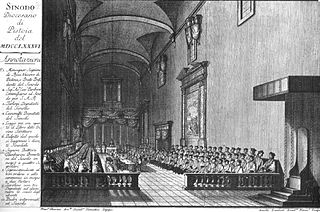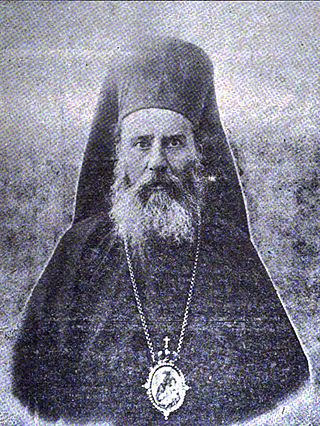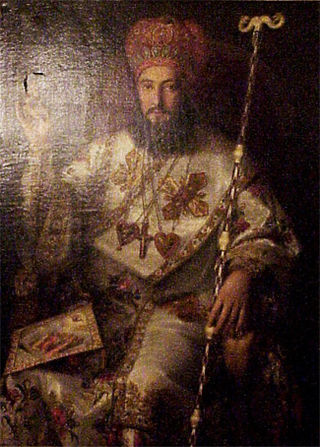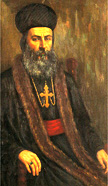Related Research Articles

The Synod of Pistoia was a 1786 diocesan synod in the Catholic diocese of Pistoia, then part of the territory of the Grand Duchy of Tuscany. It was summoned by its bishop Scipione de' Ricci under the patronage and active support of the Habsburg-Lorraine Grand Duke Leopold. The synod adopted a series of decrees of Febronian or Gallican tendency, against the background of Enlightenment thinking. Leopold hoped the synod's resolutions would be taken up by a "national" council and increase state autocratic control over the Church in Tuscany. However, in 1787 the ensuing synod of bishops rejected the Pistoia decrees, and in 1794 Pope Pius VI condemned 85 of them, leading Ricci to recant.

The Melkite Greek Catholic Church, or Melkite Byzantine Catholic Church, is an Eastern Catholic church in full communion with the Holy See as part of the worldwide Catholic Church. Its chief pastor is Patriarch Youssef Absi, headquartered at the Cathedral of Our Lady of the Dormition in Damascus, Syria. The Melkites, who are Byzantine Rite Catholics, trace their history to the early Christians of Antioch, formerly part of Syria and now in Turkey, of the 1st century AD, where Christianity was introduced by Saint Peter.
Maximos IV Sayegh was Patriarch of Antioch and All the East, and Alexandria and Jerusalem of the Melkite Greek Catholic Church from 1947 until his death in 1967. One of the fathers of Second Vatican Council, the outspoken patriarch stirred the Council by urging reconciliation between the Catholic and Eastern Orthodox churches. He accepted the title of cardinal in 1965 after Pope Paul VI clarified the significance of that title in the case of an Eastern Patriarch.

Demetrius I Qadi was Patriarch of Antioch and All the East, and Alexandria and Jerusalem of the Melkite Greek Catholic Church from 1919 until 1925.

Cyril VIII Geha, was patriarch of the Melkite Greek Catholic Church from 1902 until 1916. He was the last Melkite Catholic patriarch of the Ottoman era.
Patriarch Cyril VI Tanas, also known as Cyril VI of Antioch, became the first Patriarch of Antioch and All the East, and Alexandria and Jerusalem of the Melkite Greek Catholic Church following the schism of the Greek Orthodox Patriarchate of Antioch in 1724. Cyril re-established full communion with the Catholic Church.

The Ain Traz Seminary of the Melkite Greek Catholic Church, located southeast of Beirut, Lebanon, has served various roles during its 200-year history.

Patriarch Gregory II Youssef, also known as Gregory II Hanna Youssef-Sayour, was Patriarch of the Melkite Greek Catholic Church from 1864 to 1897. Gregory expanded and modernized the church and its institutions and participated in the First Vatican Council, where he championed the rights of the Eastern Catholic Churches.

Peter IV Barakat Géraigiry was patriarch of the Melkite Greek Catholic Church from 1898 until 1902.
Clement Michael Bahouth was patriarch of the Melkite Catholic Church from 1856 until his resignation in 1864.

Maximos III Michael Mazloum, was patriarch of the Melkite Greek Catholic Church from 1833 until 1855. As patriarch he reformed church administration and bolstered clerical education. He was also the first Melkite patriarch granted civil authority by the Ottoman Empire when the Melkites were recognized as a unique millet.
Ignatius IV (Youssef) Sarrouf was Patriarch of the Melkite Greek Catholic Church in 1812. He is remembered for both his patriarchate, and for having been, as metropolitan of Beirut, a leading figure in the early history of the Melkite Church.
Agapius II Matar, was Patriarch of the Melkite Greek Catholic Church from 1796 to 1812.
Theodosius V Dahan (1698–1788) was Patriarch of the Melkite Greek Catholic Church from 1761 to 1788.
Cyril VII Francis Siaj was Patriarch of the Melkite Greek Catholic Church from 1794 to 1796.
Germanos Adam was the Melkite Catholic bishop of the Archeparchy of Aleppo during the late 18th century and a Christian theologian.

John XI Helou (Dolce) (born in Ghosta, Lebanon - died on May 12, 1823, in Qannubin, Lebanon) (or Youhanna Helou, Al-Hilu, Arabic: يوحنا الحادي عشر الحلو, French: Jean el-Hélou, Latin: Iohannes Dolce) was the 67th Maronite Patriarch of Antioch from 1809 until his death in 1823.

Joseph VII Peter Tyan was the 66th Maronite Patriarch of Antioch from 1796 until his resignation in 1809.

Joseph VI Estephan was the 63rd Maronite Patriarch of Antioch from 1766 until his death in 1793 with the name of Joseph VI Estephan.

Youssef Absi is the current patriarch of the Melkite Greek Catholic Church, serving since June 21, 2017.
References
- ↑ Charon, Cyril (1998). History of the Melkite Patriarchates: Volume 1: Pre-Modern Period (869-1833). Fairfax: Eastern Christian Publications. p. 110–120. ISBN 1892278014.
- ↑ Charon, 1998 & p. 102.
- ↑ Charon, 1998 & p. 102–104.
- ↑ Charon, 1998 & p. 102–109.
- ↑ Charon, 1998 & p. 112-113.
- ↑ Charon, 1998 & p. 115–120.
- ↑ Greek-Catholic Diocese of Aleppo (1806). Acts of the Synod of Qarqafe. Aleppo: Greek-Catholic Diocese of Aleppo. p. i–xii.
- ↑ Welter, Hubertus (1911). Tomus Quadragesimus Sextus Synodi Melchitarum, 1712-1902. Paris: Expensis Huberti Welter, Bibliopolae. p. xxi–xxiii.
- ↑ Pope Pius IX (1873). "Quartus Supra (On the Church in Armenia)". Papal Encyclicals Online. Retrieved 21 July 2023.
However soon afterwards, in the year 1806, the so-called Antioch Synod met at the monastery of Carcapha in the diocese of Beirut. The Pistoian Synod, which had already been condemned, quietly and deceitfully influenced the synod in many matters. This synod reproduced several statements, in part verbatim and in part ambiguously expressed, even though these had been condemned by the holy Roman See...If only the errors in which it abounded had come to an end when the synod was condemned! But such wicked teachings did not cease to creep secretly throughout the East, waiting for the right moment to emerge into common view. Despite an unsuccessful attempt about twenty years ago, the new Armenian schismatics have now daringly brought this about.
- ↑ Descy, Serge (1986). Introduction à l'histoire et l'ecclésiologie de l'Eglise melkite. Beirut: Éditions Saint Paul. p. 64.
- ↑ Descy, Serge (1986). Introduction à l'histoire et l'ecclésiologie de l'Eglise melkite. Beirut: Éditions Saint Paul. p. 58–59.
Bien qu'il ait été inspiré par les idées gallicane et le synode de Pistoie à traverse l'influence d'Adam, il est l'expression officielle, cette fois, de toute la hiérarchie melkite, soucieuse de sauvegarder l'autonomie de l'Orient au sein de l'Église catholique.